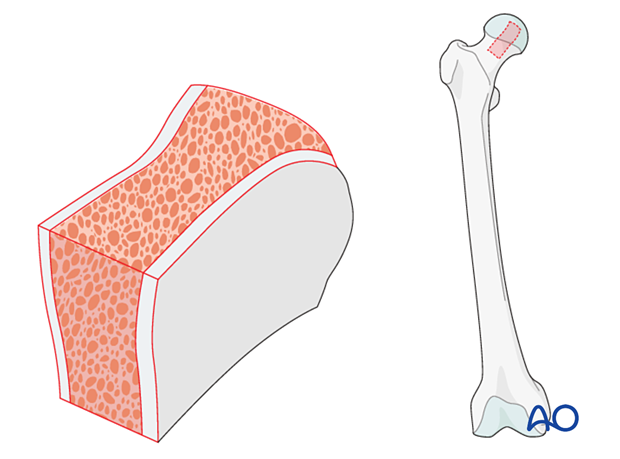Bony reconstruction with augmentation
1. Bony reconstruction
Bone loss in the glenoid can be reconstructed using allograft and/or autograft.
Allograft has a slightly higher resorption rate compared to autograft. However, for large defects, the use of autograft, eg, from the iliac crest, is limited by the volume of bone required.

A combination of bony reconstruction and metal augmentation is possible.
One-stage reconstruction of the glenoid is possible if primary stable fixation of the glenoid implant in the native glenoid can be achieved.
In more advanced cases, a two-stage reconstruction with bony augmentation in the first stage is recommended.
If infection is suspected a two-stage reconstruction is recommended with interval debridement and biopsy for specific diagnosis and antibacterial management.
Graft options
The most common autograft that is currently used is a shaped bi- or tri-cortical iliac crest bone block.

Femoral head allografts (structural or morselized) are usually an excellent resource for reconstructing glenoid vault defects.
Distal tibial allografts are a useful alternative, particularly for glenoid rim defects.

Bone graft placement (contained defects of the glenoid)
For contained defects of the glenoid bone the options for grafting include:
- Morselized bone for impaction grafting
- Structural bone shaped to fit the defect and secured by screw fixation
For either option the revision glenoid implant must be secured by primary fixation in the native glenoid bone so that:
- The bone graft is compressed by the glenoid implant for optimal healing and incorporation
- The implant fixation does not depend on fixation in the graft
Bone graft placement (non-contained defects of the glenoid)
For non-contained defects of the glenoid bone the options for reconstruction include:
- Structural bone graft shaped to fit the defect and secured by screw fixation with a standard glenoid implant
- Structural bone graft with the addition of metallic augmentation of a standard glenoid implant
- Specific (custom) metallic glenoid implant
A non-contained defect of the anterior wall of the glenoid is illustrated here.
The posterior glenoid wall is still intact: the screws are placed from anterior to posterior into the optimal bone, commonly superiorly and inferiorly.


A non-contained defect of the posterior wall of the glenoid is illustrated here.
If the anterior wall is still intact, a pre-shaped bone graft may be applied to the glenoid implant prior to implantation. The graft is compressed between the glenoid implant and the native bone. Additional screw fixation of the glenoid implant is usually required.

2. Bone replacement by metal prostheses
Metallic reconstruction can be performed using augmented baseplates or custom-made (patient-matched) glenoids.
Usually, metallic augmentation or reconstruction is done as a one-stage operation. Additional bone graft may be used.
Minor bony defects can be addressed with augmented baseplates. These may be:
- Angled differently to reconstruct asymmetric defects
- Different heights to restore joint biomechanics
- Both

Custom-made designs are used when there is:
- A large bone defect of the glenoid vault in which standard or augmented metallic implants, with or without bone graft, will not gain a predictable fixation
- A large bone defect with insufficient quality of the bone of the glenoid walls for secure primary fixation of a standard or augmented glenoid implant

Metallic augment placement
Metallic augment placement is performed according to the manufacturer's recommendations.
Screw trajectory is already predefined with minor variability of screw placement.
Providing secure and stable fixation of a glenoid baseplate has been achieved, a glenosphere can be inserted. Depending on the biomechanical requirement a standard, eccentric, or lateralized implant may be used.














